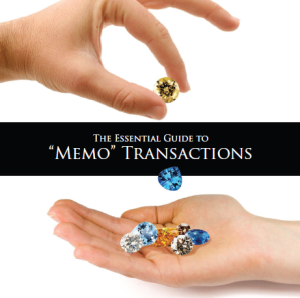 Although most pearl and bead stringers do not handle very expensive materials on a routine basis, some do. In addition, it is not at all unusual for a pearl and bead stringer to be asked to procure expensive materials for a client, South Seas Pearls, for example, or diamonds or other gemstones.
Although most pearl and bead stringers do not handle very expensive materials on a routine basis, some do. In addition, it is not at all unusual for a pearl and bead stringer to be asked to procure expensive materials for a client, South Seas Pearls, for example, or diamonds or other gemstones.
In these cases, it might be appropriate to consider asking a dealer to let you have the goods “on memo.” This is essentially a transaction where the dealer consigns goods to a merchant for a specific period of time.
There are significant risks to the consignor in this process and some dealers won’t do it. However, many do and it is a standard industry practice.
If you are considering such a request, here are some tips based on my own experience.
- Be very sure that the client is seriously interested in the goods. Casual or “browsing” interest isn’t enough. When goods are consigned, the expectation from the dealer is that they will be sold. You jeopardize your relationship when you repeatedly return unsold goods. Conversely, if you do sell the goods, it’ll be easier to obtain them on memo the next time you need to.
- Be very clear about exactly what it is that you want. Know exactly the size, cut, color and carat weight of the gemstone your client is interested in. For diamonds, understand the four C’s and be precise when you’re discussing the order with your client and with the dealer.
- Accommodate whatever paperwork the dealer requires. Some dealers are casual about consigning goods and will do it on the basis of a personal relationship. Or they will do it because you are known in the industry. However, understand that in an economic downtown, dealers have become somewhat more reluctant to let goods on memo so be prepared to accommodate whatever paperwork they require.
- Don’t take it personally if a dealer refuses to let the goods. Remember, you don’t know what show schedule he may have or what other commitments he may have made. If you’ve made the request from a dealer you don’t know and he goes to the major gem shows, take the opportunity to introduce yourself and give him your card. Do this professionally and pleasantly. There is no reason to be defensive. He made a purely business decision. But the extra effort on your part might be a persuasive factor in future potential transactions. After all, the dealer is in business and interested in expanding his client base.
- Move quickly. Do not sit on the goods. Show them to the client as soon as possible after receiving them. Remember, during the time that you have the goods, the dealer can’t sell them elsewhere. This is called an “opportunity cost” and it is a real one. If you sell the materials, it’s a nice gesture to give the dealer a call immediately and let him know the check is on the way. Then make sure it is.
- Never, ever consider asking a dealer to memo cheap or commercial goods. They will not do it and you’ll look like an amateur.
When I ran the gallery, I frequently had occasion to obtain goods on memo. Most of the dealers I worked with knew me personally and I was very careful not to jeopardize those relationships. Occasionally I had to work with dealers I didn’t know. However, fortunately I had a good reputation and never had any trouble getting the goods. The point here is to use care in taking advantage of this opportunity.
The American Gem Trade Association has developed a pamphlet titled “The Essential Guide to Memo Transactions” that describes the process from the point of view of the dealer. It is highly worthwhile taking a look at it to better understand the real risk dealers take in letting goods on memo.

